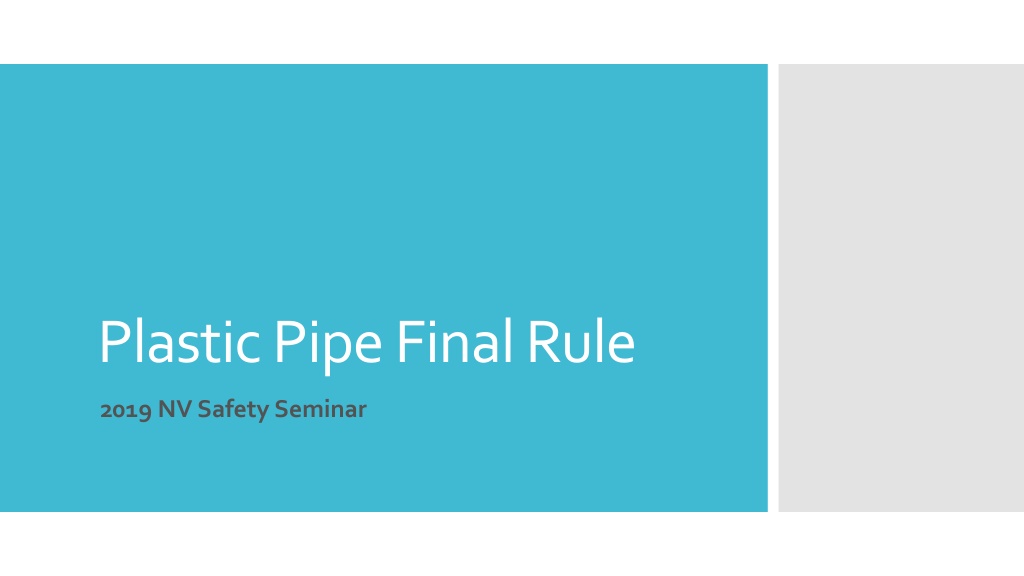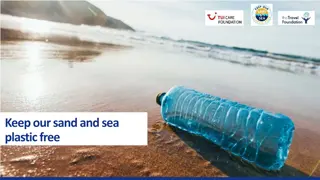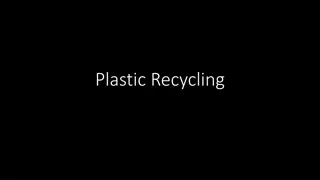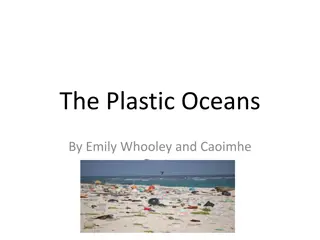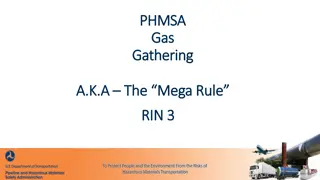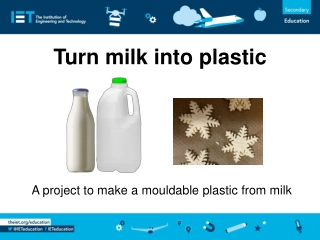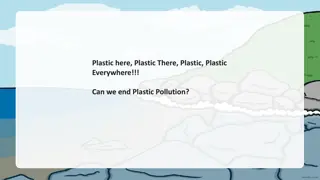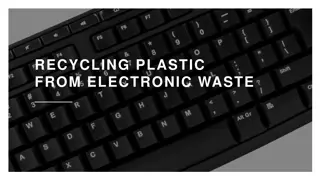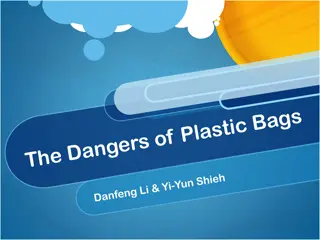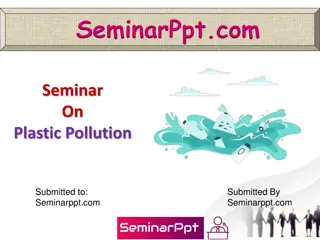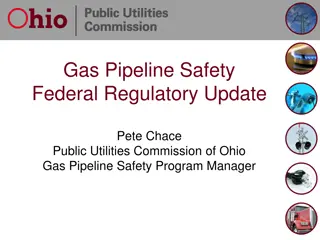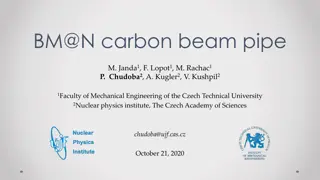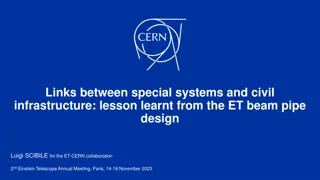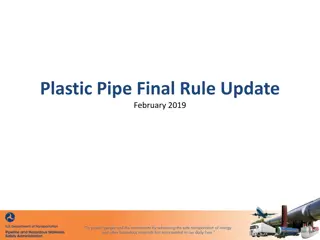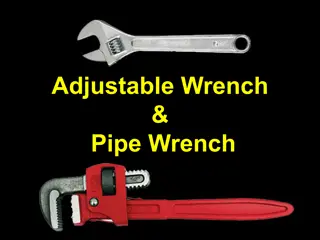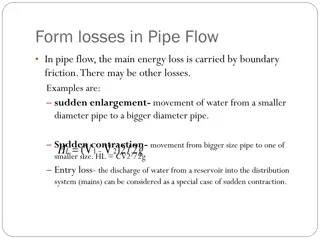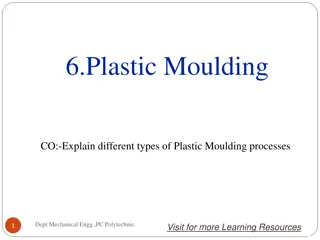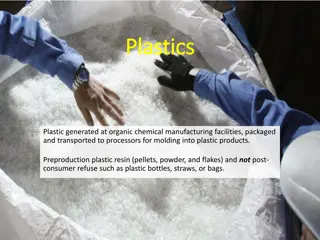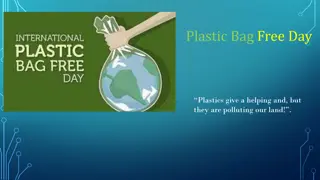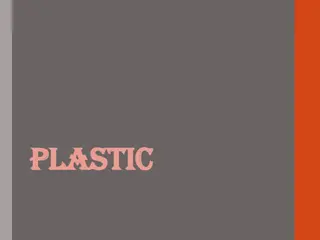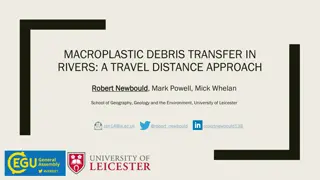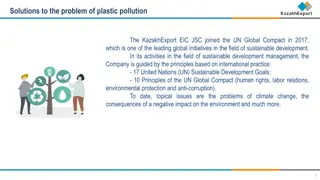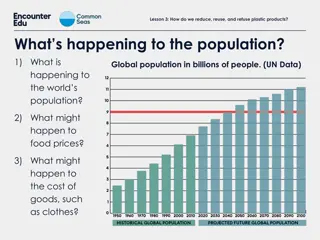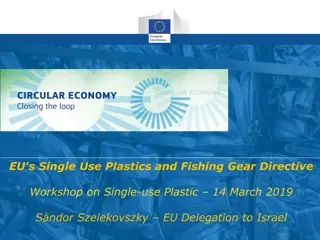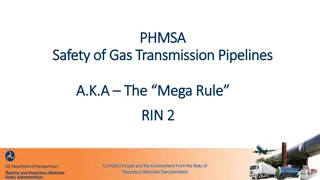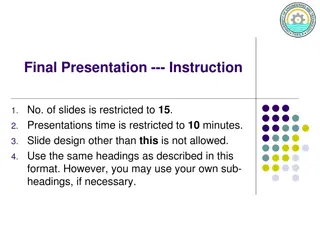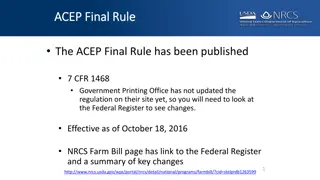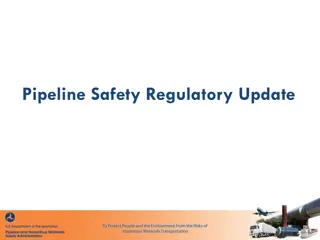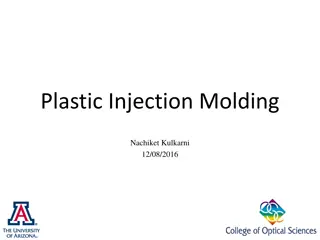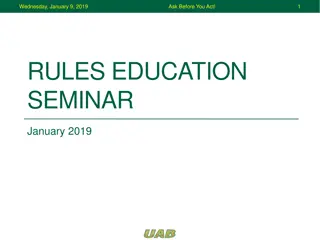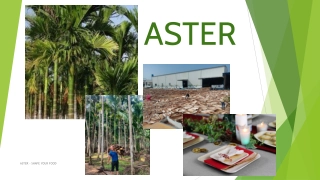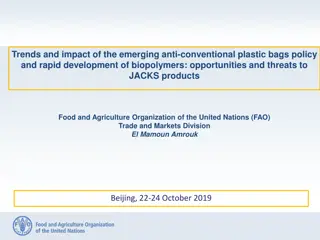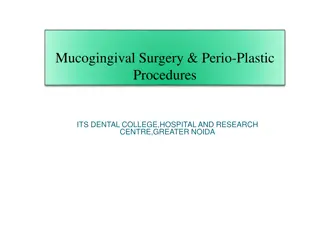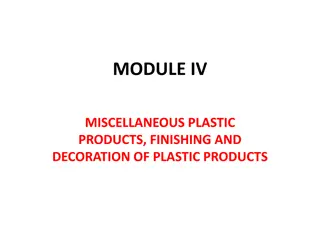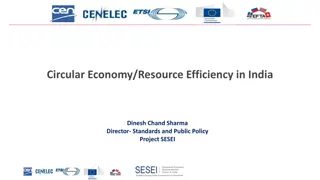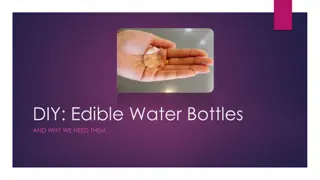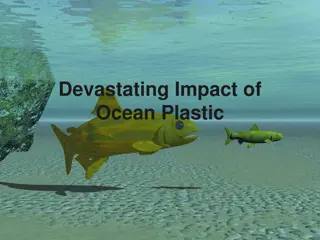PHMSA Plastic Pipe Final Rule 2019 Updates & Safety Seminar Details
PHMSA is amending Federal Pipeline Safety Regulations regarding the use of plastic piping systems for gas transportation. The updates aim to enhance safety, adopt innovative technologies, and respond to stakeholder petitions. Changes include higher pressures for PE and PA, new standards for fittings and joints, updated testing requirements, new riser requirements, and more. Effective from January 22, 2019, these amendments incorporate new weak link definitions and equipment calibration requirements.
Download Presentation

Please find below an Image/Link to download the presentation.
The content on the website is provided AS IS for your information and personal use only. It may not be sold, licensed, or shared on other websites without obtaining consent from the author. Download presentation by click this link. If you encounter any issues during the download, it is possible that the publisher has removed the file from their server.
E N D
Presentation Transcript
Plastic Pipe Final Rule 2019 NV Safety Seminar
Bryan Kichler Transportation Specialist U.S. Department of Transportation PHMSA Inspector Training and Qualifications Email: Bryan.Kichler@dot.gov Contact Information
DEPARTMENT OF TRANSPORTATION Pipeline and Hazardous Materials Safety Administration 49 CFR Part 192 [Docket No. PHMSA-2014-0098: Amdt. No. 192-124] RIN 2137-AE93 Pipeline Safety: Plastic Pipe Rule Plastic Pipe Final Rule
PHMSA is amending the Federal Pipeline Safety Regulations that govern the use of plastic piping systems in the transportation of natural and other gas. These amendments are necessary to enhance pipeline safety, adopt innovative technologies and best practices, and respond to petitions from stakeholders. SUMMARY
Higher pressures for PE and PA Larger PA-11 pipe Polyamide-12 pipe More stringent standards for plastic fittings and joints Updated testing requirements for joiners New riser requirements Category 1 mechanical fittings Updated standards New installation requirements Equipment calibration requirements SUMMARY
DATES: The effective date of these amendments is January 22, 2019. The incorporation by reference of certain publications listed in the rule is approved by the Director of the Federal Register as of January 22, 2019. AGA has petitioned for some changes to the rulemaking and extended implementation times SUMMARY
New Weak link means a device or method used when pulling polyethylene pipe, typically through methods such as horizontal directional drilling, to ensure that damage will not occur to the pipeline by exceeding the maximum tensile stresses allowed. New Definition
Standard updates across the board for plastic pipe Standard updates for fittings Additional standards for PA-11 and PA-12 (polyamide) Standard for repair of PVC segments Standards Updates
New Newly constructed type B gathering lines must now comply with the plastic pipe requirements found in Part 192 Gathering lines
192.59 now specifies that operators must verify that all pipe is free of visible defects prior to installation and permit the use of pipe that had been previously used in gas service other than natural gas. Inspection
192.63 Plastic pipe must now meet the marking requirements from the applicable specification for which it was manufactured Updated Pipe Marking
New 192.67 Each operator must have and follow written procedures for the storage and handling of plastic pipe and associated components that meet the applicable listed specifications. Storage
192.121 has been combined with 192.123 Design limitations have been merged into 192.121 Addition of PA-12 pipe Larger diameters of PA-11 PA-11 and PA-12 tubing is now allowed New installations of PA can operate up to 250 psig New .40 design factor for PE (previously .32) Design
192.123 has been removed and reserved Removed
192.143 General requirements. For clarity, PHMSA added a new paragraph (c) to specify that components used for plastic pipe must be able to withstand operating pressures and anticipated loads in accordance with a listed specification, as defined in 192.3. Loading
192.145 PHMSA has added a new paragraph (f) to specify that plastic valves must be designed to meet a listed specification as defined in 192.3 and not operated in conditions that exceed the applicable pressure or temperature ratings detailed in the applicable listed specification. Valves
192.149 Standard fittings. (c) Plastic fittings installed after January 22, 2019, must meet a listed specification. Fittings Section 192.191 Design Pressure of Plastic Fittings Removed and Reserved
New 192.204 Risers installed after January 22, 2019. (a) Riser designs must be tested to ensure safe performance under anticipated external and internal loads acting on the assembly. (b) Factory assembled anodeless risers must be designed and tested in accordance with ASTM F1973 13 Risers
NewCont. 192.204 Risers installed after January 22, 2019. (c) All risers used to connect regulator stations to plastic mains must be rigid and designed to provide adequate support and resist lateral movement. Anodelessrisers used in accordance with this paragraph must have a rigid riser casing. Risers
192.281 Solvent cements are now to comply with ASTM D2564-12 The joint may not be heated or cooled to accelerate the setting of the cement. Joining of PVC
192.281 Cont. All heat fusion joints other than electrofusion must comply with ASTM F2620-12 Joining of PE
192.281 Cont. A socket heat-fusion joint must be joined by a device that heats the mating surfaces of the pipe or component, uniformly and simultaneously, to establish the same temperature. The device used must be the same device specified in the operator's joining procedure for socket fusion. Socket Fusion
192.281 Cont. (c)(3) An electrofusion joint must be made using the equipment and techniques prescribed by the fitting manufacturer, or using equipment and techniques shown, by testing joints to the requirements of 192.283(a)(1)(iii), to be equivalent to or better than the requirements of the fitting manufacturer. Electrofusion
192.281 Cont. (e)(4) All mechanical joints or fittings installed after January 22, 2019, must be Category 1 as defined by a listed specification for the applicable material, providing a seal plus resistance to a force on the pipe joint equal to or greater than that which will cause no less than 25% elongation of pipe, or the pipe fails outside the joint area if tested in accordance with the applicable standard. Mechanical Fittings
192.283 Plastic pipe: Qualifying joining procedures. (a) Heat fusion, solvent cement, and adhesive joints. Before any written procedure established under 192.273(b) is used for making plastic pipe joints by a heat fusion, solvent cement, or adhesive method, the procedure must be qualified by subjecting specimen joints that are made according to the procedure to the following tests, as applicable: Qualifying Joining Procedures
192.283 Cont. Testing Thermoplastic Pipe Sustained Pressure Test or the Minimum Hydrostatic Burst Test Qualifying Joining Procedures Testing Electrofusion Fittings Tensile Strength Test or the Joint Integrity Test Testing Thermosetting Pipe Minimum Hydrostatic Burst Pressure or Sustained Static Pressure Test
192.283 Cont. PHMSA is also repealing the obsolete 192.283(d), which allowed operators to install used pipe or fittings manufactured before July 1, 1980, if they are joined in accordance with procedures that the manufacturer certifies will produce a joint strong as the pipe. Qualifying Joining Procedures
192.285 Except for electrofusion, PE joints made during joiner qualification must be visually inspected and tested in accordance with ASTM F2620-12 Plastic Joiner Qualification
192.313 Section 192.313 details standards for bends and elbows in pipe, however, it did not previously address plastic pipe. This final rule adds a new paragraph (d) requiring that operators may only make bends in plastic pipe with a bend radius greater than the minimum bend radius specified by the manufacturer. Bends
192.321 Clarifications on protection of pipe on both entry and the exit of insertions References to 192.123 have been moved to 192.121 Installations of risers at regulator stations must meet the design requirements of 192.204. Plastic Installations
New 192.329 Installation of plastic pipelines by trenchless excavation. Plastic pipelines installed by trenchless excavation must comply with the following: (a) Each operator must take practicable steps to provide sufficient clearance for installation and maintenance activities from other underground utilities and/or structures at the time of installation. (b) For each pipeline section, plastic pipe and components that are pulled through the ground must use a weak link, as defined by 192.3, to ensure the pipeline will not be damaged by any excessive forces during the pulling process. Trenchless Excavation
192.367 Similar to the new requirements for other fittings, paragraph (b) is amended to require that operators must use Category 1 compression-type fittings. 192.367 (b)(3) If used on pipelines comprised of plastic, be a Category 1 connection as defined by a listed specification for the applicable material, providing a seal plus resistance to a force on the pipe joint equal to or greater than that which will cause no less than 25% elongation of pipe, or the pipe fails outside the joint area if tested in accordance with the applicable standard. Pipe Connections
New 192.376 Installation of plastic service lines by trenchless excavation. Plastic service lines installed by trenchless excavation must comply with the following: (a) Each operator shall take practicable steps to provide sufficient clearance for installation and maintenance activities from other underground utilities and structures at the time of installation. (b) For each pipeline section, plastic pipe and components that are pulled through the ground must use a weak link, as defined by 192.3, to ensure the pipeline will not be damaged by any excessive forces during the pulling process. Trenchless Service Lines
192.455 Electrically isolated metal alloy fittings installed after January 22, 2019, that do not meet the requirements of paragraph (f) must be cathodically protected, and must be maintained in accordance with the operator's integrity management plan. Corrosion
Section 192.513 details the minimum initial testing requirements for plastic pipelines. The final rule amends paragraph (c) to reduce the maximum limit for testing pressure from 3 times the pressure determined under 192.121 to 2.5 times the maximum pressure to avoid overstressing the line during testing. Testing
192.720 Distribution systems: Leak repair. Mechanical leak repair clamps installed after January 22, 2019 may not be used as a permanent repair method for plastic pipe. Repair Clamps
New 192.756 Joining plastic pipe by heat fusion; equipment maintenance and calibration. Each operator must maintain equipment used in joining plastic pipe in accordance with the manufacturer's recommended practices or with written procedures that have been proven by test and experience to produce acceptable joints. Calibration and Maintenance of Equipment
Questions? Thanks! Bryan.Kichler@dot.gov
